2016四川大学902真题
- 格式:docx
- 大小:14.45 KB
- 文档页数:2
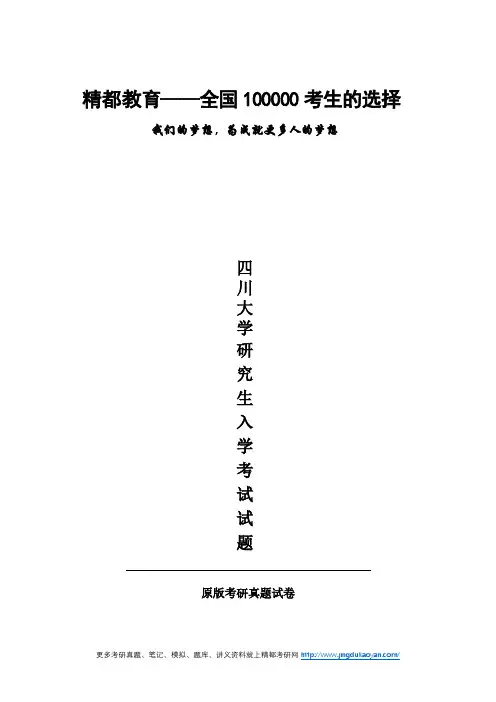
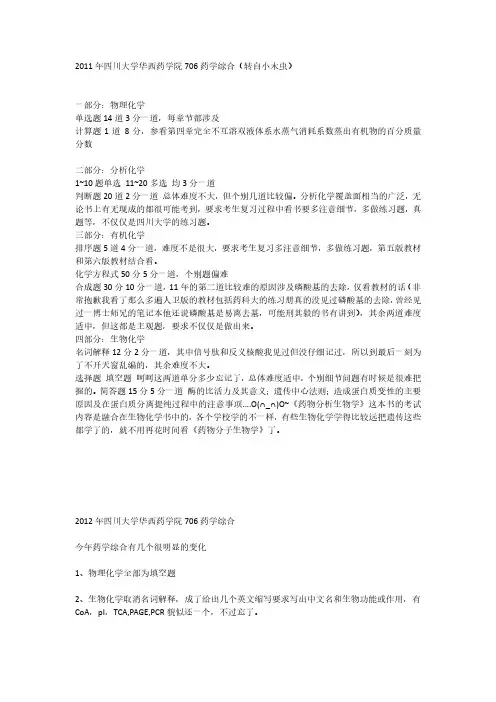
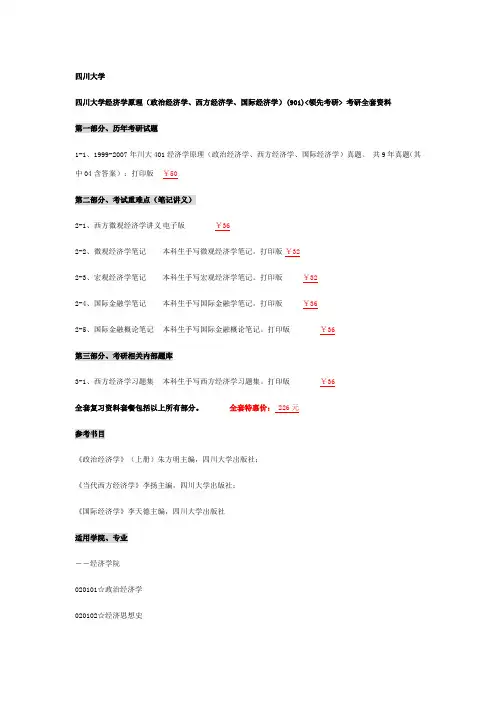
四川大学四川大学经济学原理(政治经济学、西方经济学、国际经济学)(901)<领先考研> 考研全套资料第一部分、历年考研试题1-1、1999-2007年川大401经济学原理(政治经济学、西方经济学、国际经济学)真题。
共9年真题(其中04含答案):打印版¥50第二部分、考试重难点(笔记讲义)2-1、西方微观经济学讲义电子版¥362-2、微观经济学笔记本科生手写微观经济学笔记。
打印版¥322-3、宏观经济学笔记本科生手写宏观经济学笔记。
打印版¥322-4、国际金融学笔记本科生手写国际金融学笔记。
打印版¥362-5、国际金融概论笔记本科生手写国际金融概论笔记。
打印版¥36第三部分、考研相关内部题库3-1、西方经济学习题集本科生手写西方经济学习题集。
打印版¥36全套复习资料套餐包括以上所有部分。
全套特惠价: 226元参考书目《政治经济学》(上册)朱方明主编,四川大学出版社;《当代西方经济学》李扬主编,四川大学出版社;《国际经济学》李天德主编,四川大学出版社适用学院、专业――经济学院020101☆政治经济学020102☆经济思想史020104☆西方经济学020105☆世界经济020106☆人口、资源与环境经济学四川大学法学综合B(刑法、民商法、诉讼法(刑诉民诉)(905) <领先考研>考研全套资料第一部分、历年考研试题1-1、1998-2004,2006-2007年川大405法学综合B(刑法、民商法、诉讼法(刑诉民诉)真题。
共9年真题:刑法97-06年,民商法05-06年,诉讼法98-06年,共19份真题。
无答案。
打印版¥70第二部分、考试重难点(笔记讲义)2-1、刑法本科生课堂笔记05级本科生课堂手写笔记。
打印版¥362-2、诉讼法课堂笔记05级本科生课堂手写笔记。
打印版¥36全套复习资料套餐包括以上所有资料。
全套特惠价:122元参考书目未给定参考书适用学院、专业――法学院030101法学理论030103宪法学与行政法学030104刑法学030105民商法学030106☆诉讼法学030108环境与资源保护法学030109国际法学四川大学经济学基础及应用(货币银行学、财政学、西方经济学)(902) <领先考研>考研全套资料第一部分、历年考研试题1-1、川大402经济学基础及应用(货币银行学、财政学、西方经济学)真题。
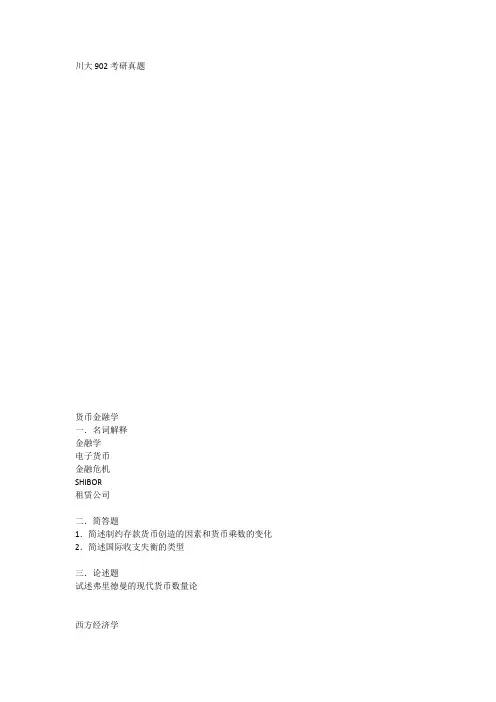
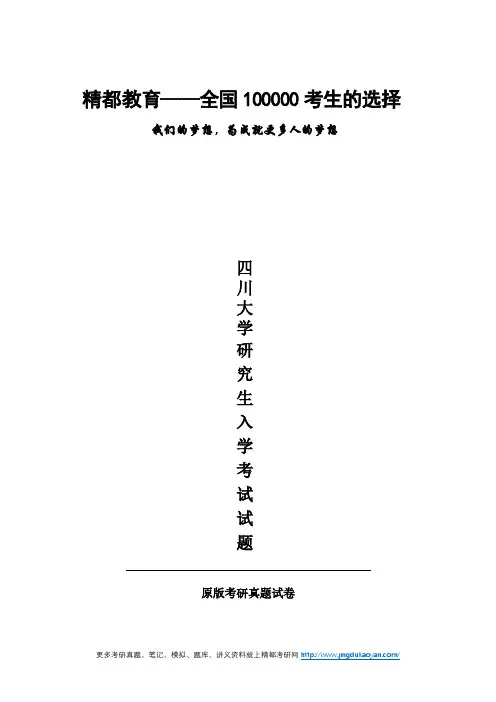
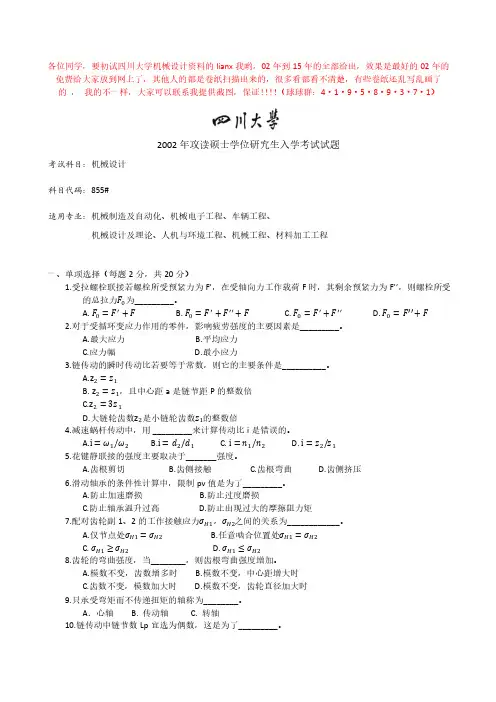
各位同学,要初试四川大学机械设计资料的lianx我哟,02年到15年的全部给出,效果是最好的02年的免费给大家放到网上了,其他人的都是卷纸扫描出来的,很多看都看不清楚,有些卷纸还乱写乱画了的,我的不一样,大家可以联系我提供截图,保证!!!!(球球群:4·1·9·5·8·9·3·7·1)2002年攻读硕士学位研究生入学考试试题:机械设计:855#:机械制造及自动化、机械电子工程、车辆工程、机械设计及理论、人机与环境工程、机械工程、材料加工工程一、单项选择(每题2分,共20分)1.受拉螺栓联接若螺栓所受预紧力为F’,在受轴向力工作载荷F时,其剩余预紧力为F’’,则螺栓所受的总拉力F0为_________。
A. F0=F′+FB. F0=F′+F′′+FC. F0=F′+F′′D. F0=F′′+F2.对于受循环变应力作用的零件,影响疲劳强度的主要因素是_________。
A.最大应力B.平均应力C.应力幅D.最小应力3.链传动的瞬时传动比若要等于常数,则它的主要条件是__________。
A.z2=z1B. z2=z1,且中心距a是链节距P的整数倍C.z2=3z1D.大链轮齿数z2是小链轮齿数z1的整数倍4.减速蜗杆传动中,用 _________来计算传动比i是错误的。
A.i=ω1/ω2B.i=d2/d1C. i=n1/n2D. i=z2/z15.花键静联接的强度主要取决于_______强度。
A.齿根剪切B.齿侧接触C.齿根弯曲D.齿侧挤压6.滑动轴承的条件性计算中,限制pv值是为了_________。
A.防止加速磨损B.防止过度磨损C.防止轴承温升过高D.防止出现过大的摩擦阻力矩7.配对齿轮副1、2的工作接触应力σH1,σH2之间的关系为____________。
A.仅节点处σH1=σH2B.任意啮合位置处σH1=σH2C. σH1≥σH2D. σH1≤σH28.齿轮的弯曲强度,当________,则齿根弯曲强度增加。
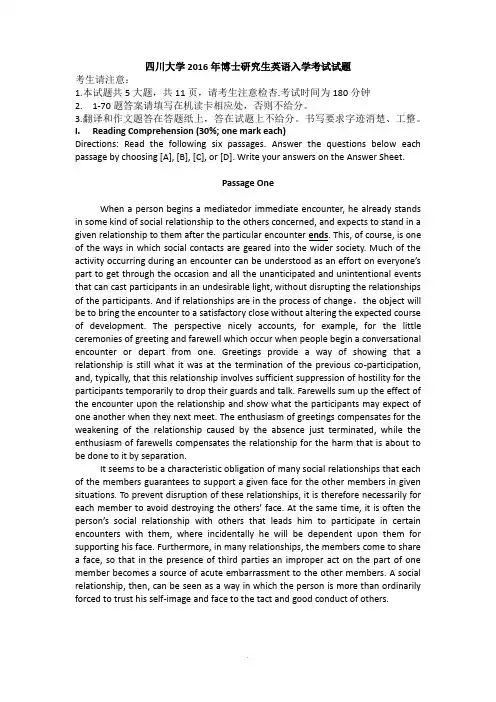
四川大学2016年博士研究生英语入学考试试题考生请注意:1.本试题共5大题,共11页,请考生注意检杏.考试时间为180分钟2. 1-70题答案请填写在机读卡相应处,否则不给分。
3.翻译和作文题答在答题纸上,答在试题上不给分。
书写要求字迹消楚、工整。
I. Reading Comprehension (30%; one mark each)Directions: Read the following six passages. Answer the questions below each passage by choosing [A], [B], [C], or [D]. Write your answers on the Answer Sheet.Passage OneWhen a person begins a mediatedor immediate encounter, he already stands in some kind of social relationship to the others concerned, and expects to stand in a given relationship to them after the particular encounter ends. This, of course, is one of the ways in which social contacts are geared into the wider society. Much of the activity occurring during an encounter can be understood as an effort on everyone’s part to get through the occasion and all the unanticipated and unintentional events that can cast participants in an undesirable light, without disrupting the relationships of the participants. And if relationships are in the process of change,the object will be to bring the encounter to a satisfactory close without altering the expected course of development. The perspective nicely accounts, for example, for the little ceremonies of greeting and farewell which occur when people begin a conversational encounter or depart from one. Greetings provide a way of showing that a relationship is still what it was at the termination of the previous co-participation, and, typically, that this relationship involves sufficient suppression of hostility for the participants temporarily to drop their guards and talk. Farewells sum up the effect of the encounter upon the relationship and show what the participants may expect of one another when they next meet. The enthusiasm of greetings compensates for the weakening of the relationship caused by the absence just terminated, while the enthusiasm of farewells compensates the relationship for the harm that is about to be done to it by separation.It seems to be a characteristic obligation of many social relationships that each of the members guarantees to support a given face for the other members in given situations. To prevent disruption of these relationships, it is therefore necessarily for each member to avoid destroying the others’ face. At the same time, it is often the person’s social relationship with others that leads him to participate in certain encounters with them, where incidentally he will be dependent upon them for supporting his face. Furthermore, in many relationships, the members come to share a face, so that in the presence of third parties an improper act on the part of one member becomes a source of acute embarrassment to the other members. A social relationship, then, can be seen as a way in which the person is more than ordinarily forced to trust his self-image and face to the tact and good conduct of others.1 .The last word of the first sentence, nam ely “ends' is most likely B .[A] a noun, meaning “purposes” or “objectives”[B] a verb, meaning “comes to a finish”[C] a postpositional adjective, me aning “finishing”[D] an adjective, meaning “purposeful”2. According to the author, if any unexpected difficulties occur in a social contact,B .[A] the relationships between the participants break up[B] those who participate will be in an unintentional event[C] all participants would try to maintain their relationships|D] the participants will certainly get through an activity3. Which of the following is NOT an idea of the author? C[A] The participants hope their relationship would be the same as they met last.[B] Greetings are just as important as farewells in a social encounter.[C] Before every greeting there is always sufficient hostility to suppress.[D] If their relationship changes, the participants want it to change as they hoped.4. The last sentence of the second paragraph means that . A[A] one’s self-image is dependent on how others behave[B] face and self-image are two different kinds of relationships[C] social relationship is something that is forced on all participants[D] to get along well with others is a process of giving each other face5. The best title for this passage may well be . A[A] Face and Social Relationship [B] How to Conduct Socially[C] Greetings and Farewells [D] Conversational SociologyPassage Two(Tips:出现人名字的地方用笔圈出来,数字用笔圈出来)The poet William Blake wrote in the early nineteenth century: “Great things are done when men and mountains meet.”Great things indeed were done on Mount Everest in May of 1996. Also poignant things, foolish things, deadly things:Hundreds of climbers from eleven different expeditions were on the mountain ---- thirty-one near the summit ---- when a freakish and fierce-some storm blew in. Eight climbers perished, the highest one-day death toll since the first expedition tried to reach the top of the world’s tallest peak in 1921.Adventurers have always sought challenges: deeper jungles, wider oceans, newer worlds. But mountains have been special. Perhaps it’s their size, the ir power, their resistance to conquest. InPatrick Mey ers’s play K2, a marooned climber on the Himalaya peak that gives the play its name delivers this li ne: “Mountains are metaphors.” And so they are. Climbers search not just for summits but also for themselves. They reach up to reach in.That helps explain why Everest has been enveloped by “Mountain Madness,”the name of a Seattle company that offers guided tours of the peak for about $65,000 (plus airfare to Nepal). New technology and equipment have also helped: lighter gear, warmer clothing, better radios and telephones. And the adventure can be shared, practically in real time, with Internet browsers around the world.But the community of high-mountain explorers now is gripped by soul-searching and second-guessing. Everest, after all, is not a theme peak. Some of the dead were experienced guides who lost their lives trying to save less agile amateurs. Said Mark Bryant, editor of Outside Magazines:“Some of us have been asking: Is it right that an average climber can order an ascent of Everest out of a catalog?” An Australian mountaineer, Tim McCartney-Snape, told the Associated Press: “Some things should remain sacred, and Everest is one of them. Even the strongest and toughest have found it can be extremely difficult just existing at that altitude, without other people depending on you.On Everest, dependency can lead to heroism and to tragedy. One frostbitten amateur, Seaborne Weathers of Dallas, was plucked from a rocky ledge at 22,000 feet by a Nepalese army helicopter — an act of incredible bravery. And Rob Hall, a guide who had climbed Everest several times, stayed on its slope with a dying customer. After learning they were hopelessly trapped, Hall managed to place a satellite telephone call to his pregnant wife, Jan, in New Zealand. “Hey, look,” he told her, “don’t worry about me.” At that moment, Hall remembered Harold, the character in K2 who muses: “Understanding has no meaning. Holding on, just holding on, that has meaning. Like Harold, he knew the mountain was still a mountain. Still a goal. Still a dream. And he couldn’t hold on. Rob Hall died before rescuers could reach him.6. Which of the following statements best describes the author’s point of view?[A] Amateurs should not be encouraged to climb Mount Everest.[B] Guided tours of Mount Everest have become a source of enormous profits.[C] In the past, Mount Everest has made heroes out of ordinary men and women.[D] Mount Everest should remain a metaphor to be talked about.7. The sentence “They reach up to reach in”may be best paraphrased by “”[A] To know the inherent meaning of a mountain, one needs to climb up to the top[B] In conquering the mountain, one finds a proof of oneself[C] Mountaineers must climb upward in order to climb inside it[D] One needs to climb up to the top to see why a mountain is metaphorical8. All of the following statements are true EXCEPT .[A] Mountain climbing can have a live report simultaneously[B] Mountaineers can be located instantly during their climbing[C] New technology significantly reduces risks and dangers in mountain climbing {D} It is more dangerous to have someone depending on you during mountain climbing9. In the last paragraph,Harold’s saying “Understanding has no meaning” means.[A] determination is more vital than thinking[B] persistence and action require reasoning[C] one should avoid misunderstanding the situation[D] it is meaningless to think in mountaineering10. Most likely, the author of this passage is .. [A] a historian[B] a mountaineer[C] a tourist guide [D] a reporterPassage 3The Hertz Corporation, the U.S. Air Force, Hyatt Hotels Corporation, the City of Dallas, and the Neiman-Marcus Group, Inc., have one thing in common----all have purchased the services of Feedback Plus. Feedback Plus is an agency that dispatches profe ssional shoppers who pose as customers. These “mystery” shoppers visit the client’s business, purchase products or services and report back to the client on the quality of service they receive. The City of Dallas hired Feedback Plus to see how car-pound employees treat citizens picking up their cars. The Air Force is using professional shoppers to assess customer service at their on-base supply stores. Banks, hospitals, and public utilities are also hiring mystery shoppers. Vickie Henry, chief executive of Feedback Plus, notes that many similar firms compete for client’s business, and service really differentiates one firm from another. Although Henry has a database of 8,800 people who serve as professional shoppers, she sometimes assumes the role of mystery shopper herself. During a recent visit to an upscale women's apparel store, she observed the type of customer service most companies attempt to avoid. None of the many salespeople on the sales floor said hello when she entered the store. When she removed a skirt from a clothing rack, none of the salespeople approached her. Finally, several minutes after entering the store, Henry approached a salesperson and asked to use the dressing room. Needless to say, service at this firm did not receive high marks from Feedback Plus.As organizations experience increased competition for clients, patients, and customers, awareness of the importance of public contact increases. They are giving new attention to the old adage “First impressions are lasting impressions.” Re search indicates that initial impressions do indeed tend to linger. Therefore, a positive first impression can set the stage for a long-term relationship.We are indebted to Susan Bixler, president of Professional Image, Inc., and author of Professional Presence, for giving us a better understanding of what it means to possess professional presence. Professional presence is a dynamic blend of poise, self-confidence, control and style that empowers us to be able to command respect in any situation. Once acquired, it permits us to be perceived as self-assured and thoroughly competent. We project a confidence that others can quickly perceive the first time they meet us.Bixler points out that, in most cases, the credentials we present during a job interview or when we are being considered for a promotion are not very different from those of other persons being considered, [t is oar professional presence that permits us to rise above the crowd. Debra Benton, a career consultant, says, “Any boss with a choice of two people with equal qualifications will choose the one with style as well as substance.” Learning to create a professional presence is one of the most valuable skills we can acquire.The development of professional presence begins with a full appreciation ofthe power of first impressions. The tendency to form impressions quickly at the time of an initial meeting illustrates what social psychologists call a primacy effect in the way people perceive one another. The general principle is that first impressions establish the mental framework within which a person is viewed, and later evidence is either ignored or reinterpreted to coincide with this framework.11. For all of the following walks of life EXCEPT the the professional presence has beendiscussed in this passage.[A] economic [B] military[C] academic [D] medical12. The underlined word “apparel” in the first paragraph means ““[A] apparatus [B] cosmetics[C] clothing [D] specialty13. Which of the following statements can be inferred from the passage?[A] No first impressions would ever change in the later contacts.[B] How one composes oneself determines how one is evaluated by others.[C] Social psychology is a science that stipulates the principles for social behaviors.[D] Opportunities in jobs or promotions are for those who differ from their competitors.14. The underlined word : “poise” in the third paragraph means:[A] proper comportment [B]desirable position[C] careful pause [D] positive assurance15. Which of the following is likely to be the title of this article?[A] The Power of First Impression[B] The Primacy Effect in Marketing[C] Social Psychology in Business[D] The Importance of FeedbackPassage FourYou can’t drive if you’re blind, or blind drunk, but an alarming number of Americans find themselves, at least occasionally, driving in a blind rage. “It’s a major social issue,”says Dr. Ricardo Martinez, administrator of the National Highway Traffic Safe ty Administration. “A 3,000-pound car in the hands of rude, hostile person is a lethal weapon.”A report on “road rage” to be released this week by the American Automobiles Association concluded that “motorists ... are increasingly being shot, stabbed, beaten, and run over for i nane reasons.” And inanity is not confined to young louts in “Baywatch” T-shirt: young men are by far the most common perpetrators, but middle-aged men and women can be equally big jerks. The most common manifestation of road rage was aggressive tailgating, followed by headlight flashing, “obscene gestures”, blocking other vehi cles, and verbal abuse. Drivers have been assaulted with weapons ranging from partially eaten burritos to canes (“a favorite with the elderly and disabled”)to golf clubs ---- and other vehicles, including buses, bulldozers, forklifts, and military tanks. “In terms of fatal crashes, drunks are a muchbigger menace,”says David Willis, president of the AAA Foundation of Traffic Safety. “But the average motorist doesn’t encounter a drunk very often, while in a place like Washington, D.C., at least once a week yo u’ll have an encounter with some crazy guy on the road.”Naturally, the phenomenon has given rise to its own therapeutic movement, whose leading practitioner is a Whittier, California, psychologist named Arnold Nerenburg. Nerenburg, who calls himself “America’s Road Rage Therapist”, has identified four stimuli that provoked road rage. The most common is feeling endange red by someone else’s driving --- for example, when another driver cuts you off or follows too closely. Others are resentment at being forced to slow down, righteous indignation at someone who breaks traffic rules or steals your parking space and ----perhaps the most dangerous, because it opens the door to an escalating exchange of hostilities ----anger at another driver who takes his own road rage out on you.The fact that most drivers are mutual strangers contributes to the volatility of highway confrontations. “There’s a deep psychological urge to release aggre ssion against an anonymous other,” Nerenburg says.Road-rage therapy tends toward the common-sensical---- “Take a deep breath and just let it go,” Nerenburg recommends. But it might help to consider that you might not be all that anonymous to the other driver. One of his patients realized the depth of his problem after he yelled an obscenity at the woman in the next car ----who turned out to be his boss s wife.16 .Which of the following statements is true according to the passage?[A] More and more Americans are using their cars to express their anger.[B] Old people and women are milder in temperament during driving.[C] Common sense might be the basis for overcoming road rage.[D] If people know each other, road rage would not happen.17. According to American Automobile Association, thepeople are more likely than all the others to be road-angered.[A] young [B] middle-aged[C]old [D] handicapped18. Which of the following is a justifiable cause for road rage, according to Dr. Nerenburg?[A] Another driver fails to observe a traffic law.[B] The parking space is occupied by another car.[C] The lane is taken by a slowly-moving car.[D] Another driver flashes the head-light.19. The underlined word “lethal” in the first paragraph means:[A] powerful[B] illegal[C] dangerous[D] deadly20. What might be the deep problem that one of Nerenburg’s patients had realized?[A] He faces a lawsuit of sex harassment.[B] He is in danger of being fired.[C] He will be fined by traffic police.[D] He falls ill and has to see a doctor.Passage FiveMost people, asked if they can think without -speech, would probably answer, “Yes, but it is not easy for me to do so. Still I know it can be done.” Language is but a garment! But what if language is not so much a garment as a prepared road or groove? It is, indeed, in the highest degree likely that language is an instrument originally put to uses lower than the conceptual plane and that thought arises as a refined interpretation of its content. The product grows, in other words, with the instrument and the thought may be no more conceivable, in its genesis and daily practice, without speech than is mathematical reasoning practicable without the lever of an appropriate mathematically symbolism. No one believes that even the most difficult mathematical proposition is inherently dependent on an arbitrary set of symbols, but it is impossible to suppose that the human mind is capable of arriving at or holding such a proposition without the symbolism.The writer, for one, is strongly of the opinion that the feeling entertained by so many that they can think, or even reason, without language is an illusion. The illusion seems to be due to a number of factors. The simplest of these is the failure to distinguish between imagery and thought. As a matter of fact, no sooner do we try to put an image into conscious relation with another than we find ourselves slipping into a silent flow of words. Thought may be a natural domain apart from the artificial one of speech, but speech would seem to the only road we know of that leads to it.21. In the first line, the underlined phrase can best be replaced by[A] most of the people [B] more people[C] more than one people [D] many people22. In line 3, the word ‘groove” is probably closest in meaning to[A] later growth [B] designated slot[C] particular path [D] ready-made viaduct23. Which of the following statements would the author of the passage agree?[A] Thought came into being earlier than language[B] It is language that makes conceptual thought possible[C] Thought is no different from mathematics because it depends on symbolism[D] Both thought and language are the interpretation of propositions.24. Which of the following statements is true according to the author?[A] The imagery is the precondition of thought[B] Thought has to be bore in words.[C] Imagery is an explanation of words.[D] Once we use words, we make mistakes.25. The idea of this passage is held by[A]some people including the writer.[B] the writer himself alone[C] most people but the writer[D] one of the people other than the writerPassage SixStrikes and strikebreaking, lockouts and boycotts, all pit one side against the other in labor disputes. Ultimately, the negative effects of such actions ---- including resentment, fear, and distrust ---- linger for months or years after a dispute has been resolved.Increasingly, more productive techniques such as mediation and arbitration are being used to settle disagreements between labor and management. Either one may come into play before a labor contract expires or after some other strategy, such as a strike, has proven ineffective.Mediation is the use of a neutral third party to assist management and the union during their negotiations. This third party (the mediator) listens to both sides, trying to find common ground for agreement. The mediator also tries to encourage communication between the two sides to promote compromise, and generally keep the negotiation moving. Initially, the mediator may meet privately with each side. Eventually, however, the goal is to get the two sides to settle their differences at the bargaining table.Unlike mediation, the arbitration step involves a formal hearing. Just as it may be the final step in a grievance procedure, it may also be used in contract negotiations when the two sides cannot agree on one or more issues. At this point, the arbitrator hears the formal positions of both parties on outstanding, unresolved issues. The arbitrator then analyzes these positions and makes a decision on the possible resolution of the issues. If both sides have agreed in advance that the arbitration will be binding, that means they must accept the arbitrator’s decision.If mediation and arbitration are unsuccessful, then according to the Taft-Hartley Act, the president of the United States can obtain a temporary injunction to prevent or to stop a strike if it would endanger national health or security.26. According to the author, with the solution of a labor crisis[A] the tension between labor and management can continue[B] labor and management do not trust each other any more[C] the negative effect of actions like strike would be resolved[D] a long time is needed to bring the dispute to an end27. To resolve a labor dispute, one should[A] resort to mediation or arbitration from the start[B] make sure that the labor contract expires[C] take other steps before going to mediation or arbitration[D] strike first and then accept mediation or arbitration28. Which of the following is true of mediation?[A] The mediator makes final decisions after meeting with both sides.[B] To avoid bias, the mediator cannot meet either side in advance.[C] The primary task is to help both sides bargain with each other.[D] The mediator can be a representative from either the labor or the management.29. The pre-condition for an arbitration to be authoritative is that[A] both sides agree in advance to abide by the decision made[B] a formal hearing must be conducted just like in a court trial[C] the decision is focused on the most outstanding and unresolved issues[D] there is no bargaining allowed by arbitration,unlike mediation30. In the last sentence, the underlined word “injunction” most likely refers to[A] a formal declaration [B] a subpoena [C] a lawsuit protocol [D] an official orderVI Vocabulary (10%; 0-5 mark each)31. Dr. Norman Bethune came from Canada to help the Chinese people in their war against Japanese aggression.[A] in the way [B] all the way [C] along the way [D] by the way32. Throughout history, he who knows the art of war uses force only as the last[A] resort [B] rescue [C] refrain [D] recant33. After a careful investigation and evaluation,the city hall decided to the old house.[A] dismantle [B] destroy [C] demolish [D] delineate34. The monument was so small that it appears to be more for than for memorial.[A] significance [B] indifference [C] oblivion [D] memory35. Millions of years ago the Vesuvian volcano destroyed Pompeii, but today it is[A] dormant [B] Pacifying [C] ignited [D] pictured36. Because humans have to talk about the limitless world by means of limited language sounds, there is a great between the world and language.[A] apathy [B]anomaly [C] asymmetry [D] agnosticism37. If an organism is quite successful in getting used with the environment that is new to it, we say that the organism is very[A] agile [B] adjustable [C] adoptive [D] adaptive38. When we do Planning, we Should take a11 relevant factors into consideration in order to as much as possible the difficult cases or even failures.[A] forestall [B] forerun [C] foretell [D] forecast39. is the practice of putting yourself in a position of another person in order to understand his/her feelings.[A] affectionate [B]empathy[C] pathology [D] affiliation40. In schools and universities, some courses are compulsory, which one has to take, while the others are( ) , either freely of as required.[A] optimal [B] opaque [C] optical [D] optional41. When one applies for a job position, one needs to ( ) one's resume, describing one's educational as well as working experiences.[A] submit [B] subject [C] submerge [D] subside42. As industry grew,so ( ) did the need for more and more skilled industrial workers.[A] much[B] as to[C] too[D] as for43. The rescue team worked hard to search for the missing mountaineers,( ) the heavy and icy snowstorm.[A] in spite [B] despite [C] although [D] disregard44. “Breaking Bad” is the most thrilling TV drama series ( ) I have watched in several years.[A] as [B] what [C] which [D] that45. The revised feasibility report handed in by the draft team is good enough, ( )a few spelling errors on some pages.[A] except for [B] except that [C] excepting [D] except46. It is mandatory that the engineering project ( ) accomplished by the end of this year.[A] is [B] has been [C] be[D] will be47. ( ) the advice from the councilor, we would not have finished the task so smoothly.[A] out of [B] what with [C] but for [D] instead of48. The traffic accident has claimed 5 lives, the cause of which is still ( ) investigation.[A] under [B] beyond [C] for [D] beneath49. Even though the bell for dismissing class has rung,the teacher is still talking ( )[A] over [B] forward [C] off [D] away50. Since the negotiation with the management has come to a deadlock, the worker's union decide to take ( ) the street.[A] to [B] over [C] down [D] away withIII Cloze (10%; 0.5 mark each)In the last decade, giving birth at home has become an increasingly popular option for some couples. Assisted by a physician or a nurse-midwife,many women have successfully given birth at home (51) A to healthy babies. In fact, some studies indicate that ―一for (52)<C>uncomplicated pregnancies --- home delivery is as safe as hospital delivery. (53) [B] Advocates of home birth argue that the atmosphere in a hospital --- with all its forbidding machines,rules, regulations, and general lack of “homeyness”---- is stressful. (54) [B] Therefore ,giving birth in a hospital detracts from what should be a joyous, natural human experience. Supporters of home birth further argue that hospitals are (55) [C] meant to deal with illness and that the delivery of a baby should not be viewed as an illness.On the other side of the argument, critics of home birth argue that if emergency medical (56) [A] procedures are necessary, giving birth at home may be (57) [B] downright dangerous. Furthermore, hospital practices in labor and delivery have changed (58) [D] radically in the last decade, particularly with the increased popularity of the Lamaze method. Thus hospitals are not the strange, forbidding environments they once were. (59) [A] Most hospitals, for example, allow fathers to be present (60) [A] at the entire labor and delivery, and many allow the father to be present (61) [A] in the operating room during the cesarean deliveries. Many hospitals have (62) [D] altogether created birth centers, homelike rooms with comfortable beds and armchairs, that allow labor and delivery to (63) [C] occur in a。
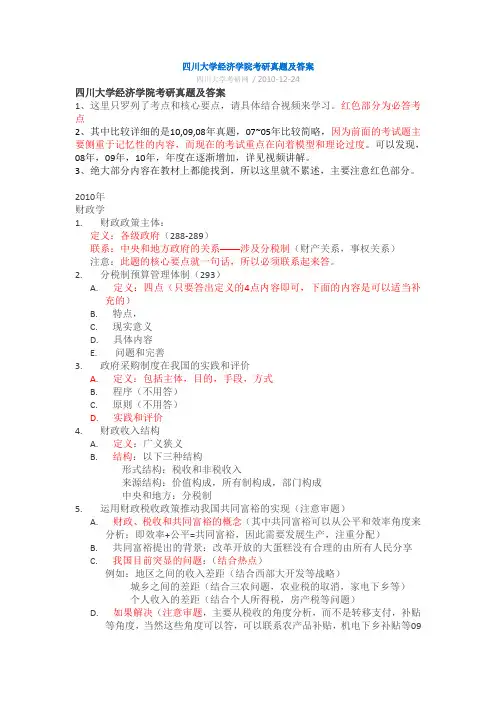
四川大学经济学院考研真题及答案四川大学考研网/ 2010-12-24四川大学经济学院考研真题及答案1、这里只罗列了考点和核心要点,请具体结合视频来学习。
红色部分为必答考点2、其中比较详细的是10,09,08年真题,07~05年比较简略,因为前面的考试题主要侧重于记忆性的内容,而现在的考试重点在向着模型和理论过度。
可以发现,08年,09年,10年,年度在逐渐增加,详见视频讲解。
3、绝大部分内容在教材上都能找到,所以这里就不累述,主要注意红色部分。
2010年财政学1.财政政策主体:定义:各级政府(288-289)联系:中央和地方政府的关系——涉及分税制(财产关系,事权关系)注意:此题的核心要点就一句话,所以必须联系起来答。
2.分税制预算管理体制(293)A.定义:四点(只要答出定义的4点内容即可,下面的内容是可以适当补充的)B.特点,C.现实意义D.具体内容E.问题和完善3.政府采购制度在我国的实践和评价A.定义:包括主体,目的,手段,方式B.程序(不用答)C.原则(不用答)D.实践和评价4.财政收入结构A.定义:广义狭义B.结构:以下三种结构形式结构:税收和非税收入来源结构:价值构成,所有制构成,部门构成中央和地方:分税制5.运用财政税收政策推动我国共同富裕的实现(注意审题)A.财政、税收和共同富裕的概念(其中共同富裕可以从公平和效率角度来分析:即效率+公平=共同富裕,因此需要发展生产,注重分配)B.共同富裕提出的背景:改革开放的大蛋糕没有合理的由所有人民分享C.我国目前突显的问题:(结合热点)例如:地区之间的收入差距(结合西部大开发等战略)城乡之间的差距(结合三农问题,农业税的取消,家电下乡等)个人收入的差距(结合个人所得税,房产税等问题)D.如果解决(注意审题,主要从税收的角度分析,而不是转移支付,补贴等角度,当然这些角度可以答,可以联系农产品补贴,机电下乡补贴等09年热点措施)主要从税率(比如资源税,地区税率的差异),税种以及具体的税种的改进说起(比如个人所得税如何改进,房产税应该怎样征收,农业税为什么全面取消)注意:结合热点问题,尽量多答西经1.均衡汇率A.定义:内外均衡同时实现时的汇率B.内部均衡:充分就业C.外不均衡:国际收支平衡D.可以结合“政策配合理论”详见国际金融2.利润最大化原则A.厂商的原则:利润最大化MAX:L=R-C 利润=收益-成本B,利润最大化的数学条件:一阶条件MR=MC(二阶条件:二阶导数小于0)C.短期中:图形(详见视频)数学条件(P*MPx=W1)D.长期:图形(详见书上的等产量和等成本线)数学条件P*MPx1=W1, P*MPx2=W2E.可以结合显示偏好原理来补充3.瓦尔拉斯一般均衡理论(详见视频和其他教材,如高鸿业)A.定义:市场均衡+一般均衡B.数学条件(略):对商品的超额需求为0C.瓦尔拉斯法则:用货币表示的超额需求=0D.解释:瓦尔拉斯均衡和瓦尔拉斯法则的对比N个市场,已知N-1个均衡,则剩下的的一个市场也均衡4.内生增长理论(详见视频和高鸿业西经)A.外生增长:索罗模型——将技术看成外生的B.内生增长:Y=AK模型或者两部门模型,二者答一即可。
货币金融学(60分)
一、名词解释(每小题4分,共20分。
)
1.货币供给量
2.无限法偿货币
3.数量型货币政策工具
4.期权合约
5.金融危机
二、判断分析题(判断正误,阐明理由。
每小题6分,本大题共24分)
1.布雷顿森林体系实际上是一种国际金币本位制。
2.适度货币需要量与实际货币需要量是有区别的。
3.商业银行具有多重职能。
4.由于流动性的不同,货币分为不同的层次。
三、论述题(本题共16分。
)
论我国的利率市场化及其影响。
西方经济学(90分)
四、名词解释(每小题4分,共20分)
1.长期总成本
2.边际报酬递减规律
3.纳什均衡
4.摩擦性失业
5.流动性偏好
五、计算题(每小题10分,共20分)
1,假定某垄断厂商生产的产品的需求函数为P=600-2Q,成本函数为CP=3Q²-400Q+40000(产量以吨计,价格以元计)。
1)试求厂商利润最大时的产量、价格和利润。
2)若每增加1单位产量,由于外部不经济(环境污染)会使社会受到损失,从
而使社会成本(包含厂商成本)函数为:CS=4.25Q²-400Q+40000,试求此时最优的产量和价格?
3)若政府决定对每单位产品征收污染税,税率为多少才能使企业产量与社会的
最优产量相一致?
2,假定某经济存在以下关系:消费C=800+0.8Y(Y为可支配收入),税收T=0.25Y,投资I=200-50r(r为利率),政府购买G=200,货币需求L=0.4Y-100r,名义货币供给为900,总供给函数为Y=2350+400P,试求:
1)总供给和总需求均衡时的收入Y和价格水平P;
2)假定该经济充分就业的收入为2850,试问:该体系是否实现充分就业?此时
当局应采取什么政策以实现宏观经济目标?
六、简答题(每小题10分,共20分)
1.为什么说一级价格歧视下的资源配置是有效率的?
2.新古典宏观经济学有哪些基本假设?
七、论述题(每小题15分,共30分)
1.请利用完全竞争条件下要素的使用原则,说明劳动供给曲线为什么有可能向
后弯曲?
2.请用蒙代尔—弗莱明模型说明浮动汇率制度下财政政策与货币政策的效应。